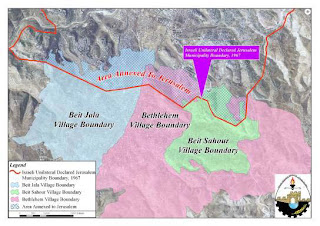Historically,
the three cities of Bethlehem, Beit Jala, and Beit Sahour have developed to
constitute the urban hub and the service centre of the Bethlehem Governorate.
These three cities have a monolithic relationship that shares a rich pool of
natural resources and a common socio-cultural context. The Bethlehem
Governorate is one of the largest of the eleven West Bank governorates. It
occupies 607.8 km2 of mass land and borders the Jerusalem Governorate in the
north and the Hebron Governorate in the south. The western borders of the
Bethlehem Governorate are the 1949 Armistice Line (Green Line), which was
demarcated by designated United Nations (UN) resolutions.
Source: The Applied Research Institute-Jerusalem (ARIJ)
According
to the 1997 Census carried by the Palestinian Central Bureau of Statistics, the
urban population in Bethlehem Governorate was 44,880 inhabitants. The
population grew to reach 58,243 in the
mid of 2004 and increased to 60,123 in the mid of 2005. This indicates that the
population grew by 33.96% between these past
eight years. The
total population of the governorate according to the Palestinian Central Bureau
of Statistics (PCBS) in the year 2007 was projected to be 176,515 Palestinians.
The same source states in “Palestine in Figures, 2011” the presence of 13 settlements
that were built on Palestinian land with 16,490 Israeli settlers. Out of the
total Palestinian population, 44.8% live in the rural areas and 39% in urban
communities, 7.5% in refugee camps.
The
Palestinian population in general, including that of Bethlehem, is young with
46.9% aged less than 15. Fifty percent of Palestinians live in households of
seven members or less. Out of the households, 91% live in crowded conditions,
i.e. with more that 1 person per room.
The
natural annual growth rate of the population is estimated at about 2.097%
according to projections in 2011. The Bethlehem Governorate just as the
rest of the Palestinian areas, suffered an increasing drop in income during the
last few years. It is estimated that for the period 1992-1996 real GNP per
capita dropped by 39.4% for the West Bank and unemployment rate for the West
Bank averaged 29% in mid 1996.
The
area has an equal measure by churches and mosques, a symbol of the increased
intermingling of the region's people. The religious and cultural diversity of
the local population is further enriched by the social diversity of the urban
population versus villagers and farmers of the western rural slopes, the
Bedouins of the eastern desert slopes and the refugees who, since the war of
1948, live in refugee camps in the peripheries of the town of Bethlehem.
The
main three cities of Bethlehem, Beit Sahour, and Beit Jala are inhabited by one
of the oldest Christian communities in the world, although the size of the
community has shrunk due to emigration.
Emigration
has affected Palestine a lot. Due to the continuous unrest, occupation, and
search for means of living the emigration drain started in the twentieth
century. Bethlehem area is not different from other Palestinian areas. The
first strong wave of migration took place after the First World War and mostly
to Latin America. The continuous economic difficulties forced this migration to
continue until today and it is reported that nearly 55% of the local Christians
are currently living in the Diaspora within affluent societies. The emigration
of some of the district's urban population and successful international trade
with east and west at the turn of the century allowed the repatriation of
riches and the construction of the beautiful homes in greater Bethlehem area.
On the other hand this movement caused the loss of the young and educated
elements. It is reported that 57.38% of the households in the Bethlehem
District have close relatives living abroad. Most (60.3%) of the relatives
abroad live in Jordan. About 32.2% of the relatives living abroad have an
Israeli identity card, and 18.2% lost their ID card. The corresponding figures
for the remaining West Bank are 42.5% and 15.4% respectively.
Christians
constitute (28%) of the district total population and (72%) are Moslems.
(92%) of the working force in the Bethlehem district are permanent
residents, while (2%) live elsewhere in the West Bank, (2%) in Jordan, (2%) in
other Arab countries and 2% outside the Middle East region. Bethlehem
Governorate population makes up (7.3%) of the West Bank population.
At the
end of the year 2011 the PCBS projected number of Palestinians in the world to
be 11.22 million, of whom 4.23 million are in the 1967 occupied Palestine, 1.37
million in Israel (1948 occupied Palestine), 4.99 million in Arab countries and
around 636 thousand in other countries. However, the total fertility rate in
the West Bank and Gaza has declined in 2010 to 4.2 births compared with 6
births in 1997, while it is lower in Bethlehem governorate.
.
Overall the total fertility rate (the number of children a woman will get under
prevailing fertility conditions) is 4.97, and it is 5.61 for the remaining West
Bank. There is evidence that fertility has started to decline in this District
as in the remaining West Bank as a whole. On the average, a married Palestinian
woman has 4.86 children, of which 0.31 are dead. The corresponding figures for the
remaining West Bank are 4.82 and 0.30, respectively. Currently the age at first
birth is 19.51 years. Of the households, about 2 1 % have no children below 1 5
living with one or both of their parents, compared to 22% in the remaining West
Bank.
Having
shown a steady decline in recent years, the infant mortality rate was 3 per
thousand births, while the child mortality (U5MR) was 38, on average.

No comments:
Post a Comment